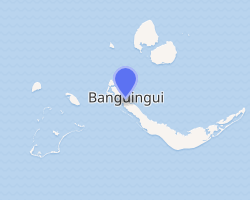Banguingui, Sulu
Banguingui, officially the Municipality of Banguingui (Tausūg: Dāira sin Banguingui; Tagalog: Bayan ng Banguingui), is a 4th class municipality in the province of Sulu, Philippines. According to the 2015 census, it has a population of 24,161 people.[3]
Banguingui Tongkil | |
|---|---|
| Municipality of Banguingui | |
 Map of Sulu with Banguingui highlighted | |
OpenStreetMap 
| |
.svg.png) Banguingui Location within the Philippines | |
| Coordinates: 6°04′N 121°47′E | |
| Country | |
| Region | Bangsamoro Autonomous Region in Muslim Mindanao (BARMM) |
| Province | Sulu |
| District | 2nd District |
| Barangays | 14 (see Barangays) |
| Government | |
| • Type | Sangguniang Bayan |
| • Mayor | Whajid I. Sahidulla |
| • Vice Mayor | Denrasher A. Abdilla |
| • Congressman | Munir M. Arbison |
| • Electorate | 12,573 voters (2019) |
| Area | |
| • Total | 352.59 km2 (136.14 sq mi) |
| Population (2015 census)[3] | |
| • Total | 24,161 |
| • Density | 69/km2 (180/sq mi) |
| • Households | 4,184 |
| Economy | |
| • Income class | 4th municipal income class |
| • Poverty incidence | 51.26% (2015)[4] |
| • Revenue (₱) | 77,512,300.34 (2016) |
| Time zone | UTC+8 (PST) |
| ZIP code | 7406 |
| PSGC | |
| IDD : area code | +63 (0)68 |
| Climate type | tropical climate |
| Native languages | Tausug Tagalog |
| Website | www |
From its original name Tongkil, it was renamed Banguingui on January 29, 1999 by virtue of Muslim Mindanao Autonomy Act No. 71 of the Autonomous Region in Muslim Mindanao in honor of the dominant Banguingui tribe of the municipality.[5][6] It was inaugurated only on January 29, 2006.[7]
Barangays
Tongkil is politically subdivided into 14 barangays.
- Bakkaan
- Bangalaw
- Danao
- Dungon
- Kahikukuk
- Luuk (Poblacion)
- North Paarol
- Sigumbal
- South Paarol
- Tabialan
- Tainga-Bakkao
- Tambun-bun
- Tattalan
- Tinutungan
Climate
| Climate data for Banguingui, Sulu | |||||||||||||
|---|---|---|---|---|---|---|---|---|---|---|---|---|---|
| Month | Jan | Feb | Mar | Apr | May | Jun | Jul | Aug | Sep | Oct | Nov | Dec | Year |
| Average high °C (°F) | 28 (82) |
27 (81) |
28 (82) |
28 (82) |
28 (82) |
28 (82) |
28 (82) |
28 (82) |
28 (82) |
28 (82) |
28 (82) |
28 (82) |
28 (82) |
| Average low °C (°F) | 27 (81) |
27 (81) |
27 (81) |
27 (81) |
28 (82) |
28 (82) |
28 (82) |
28 (82) |
28 (82) |
28 (82) |
28 (82) |
27 (81) |
28 (82) |
| Average precipitation mm (inches) | 148 (5.8) |
110 (4.3) |
116 (4.6) |
127 (5.0) |
241 (9.5) |
318 (12.5) |
304 (12.0) |
281 (11.1) |
202 (8.0) |
262 (10.3) |
227 (8.9) |
164 (6.5) |
2,500 (98.5) |
| Average rainy days | 17.0 | 14.6 | 15.5 | 15.8 | 23.3 | 24.4 | 24.8 | 24.0 | 20.2 | 22.5 | 21.0 | 18.7 | 241.8 |
| Source: Meteoblue [8] | |||||||||||||
Demographics
| Year | Pop. | ±% p.a. |
|---|---|---|
| 1903 | 1,000 | — |
| 1918 | 8,212 | +15.07% |
| 1939 | 2,893 | −4.85% |
| 1948 | 3,673 | +2.69% |
| 1960 | 5,816 | +3.90% |
| 1970 | 9,095 | +4.57% |
| 1975 | 14,062 | +9.13% |
| 1980 | 15,716 | +2.25% |
| 1990 | 10,469 | −3.98% |
| 1995 | 12,971 | +4.10% |
| 2000 | 15,933 | +4.51% |
| 2007 | 22,502 | +4.88% |
| 2010 | 17,802 | −8.17% |
| 2015 | 24,161 | +5.99% |
| Source: Philippine Statistics Authority[3][9][10][11] | ||
References
- "Municipality". Quezon City, Philippines: Department of the Interior and Local Government. Retrieved 31 May 2013.
- "Province: Sulu". PSGC Interactive. Quezon City, Philippines: Philippine Statistics Authority. Retrieved 12 November 2016.
- Census of Population (2015). "ARMM – Autonomous Region in Muslim Mindanao". Total Population by Province, City, Municipality and Barangay. PSA. Retrieved 20 June 2016.
- "PSA releases the 2015 Municipal and City Level Poverty Estimates". Quezon City, Philippines. Retrieved 12 October 2019.
- "Muslim Mindanao Autonomy Act No. 71; An Act Changing the Name of the Municipality of Tongkil in the Province of Sulu to the Municipality of Banguingui" (PDF). Regional Legislative Assembly, Autonomous Region in Muslim Mindanao. Retrieved 27 January 2016.
- "MMA Act No. 71 : An Act Changing the name of the Municipality of Tongkil in the Province of Sulu to the municipality of Banguingui" (PDF). Archived from the original (PDF) on 2014-09-03. Retrieved 2013-10-06.
- Banguingui municipality celebrates 10th anniversary
- "Banguingui, Sulu : Average Temperatures and Rainfall". Meteoblue. Retrieved 31 January 2019.
- Census of Population and Housing (2010). "ARMM – Autonomous Region in Muslim Mindanao". Total Population by Province, City, Municipality and Barangay. NSO. Retrieved 29 June 2016.
- Censuses of Population (1903–2007). "ARMM – Autonomous Region in Muslim Mindanao". Table 1. Population Enumerated in Various Censuses by Province/Highly Urbanized City: 1903 to 2007. NSO.
- "Province of Sulu". Municipality Population Data. Local Water Utilities Administration Research Division. Retrieved 17 December 2016.
External links
- Banguingui Profile at PhilAtlas.com
- Philippine Standard Geographic Code
- Philippine Census Information
- Local Governance Performance Management System
This article is issued from Wikipedia. The text is licensed under Creative Commons - Attribution - Sharealike. Additional terms may apply for the media files.